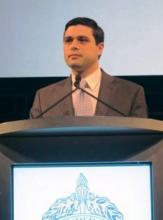MINNEAPOLIS – Achieving a 1% or less operative mortality for primary, isolated coronary artery bypass grafting is feasible only in highly selected patients, according to a multicenter Society for Thoracic Surgery database analysis.
"This goal may only be achievable in less than 60% of CABG patients without other improvements in processes of care," said Dr. Damien LaPar, chief resident in the department of surgery, University of Virginia, Charlottesville.
Dr. Michael J. Mack threw down the gauntlet in his presidential address at the STS annual meeting last year, challenging the surgical community to achieve a CABG mortality rate of 1% or less nationwide in the next 5 years (Ann. Thor. Surg. 2012;94:1044-52).
Operative mortality currently stands at about 2% for CABG versus about 1% for percutaneous coronary intervention (PCI). Use of CABG has fallen off as first-line treatment for coronary artery disease with advances in PCI technology.
Dr. LaPar and his associates used the Society of Thoracic Surgery (STS) database for adult cardiac surgery to analyze the records of 34,416 patients who had undergone CABG from 2001 to 2011 at 17 cardiac surgery centers in Virginia, representing 99% of all cardiac surgeries performed in the state. Multiple logistic regression modeling was used to identify patient populations in which the 1% mortality goal was achievable, relative to the STS Predicted Risk of Mortality (PROM) score.
The patients’ average age was 64 years and 27% were female. The median number of CABG operations performed over the 10-year study period was 544, with an operative mortality of 1.87% (644 deaths), Dr. LaPar reported at the annual meeting of the American Association for Thoracic Surgery.
The STS PROM was highly associated with CABG mortality in both linear (odds ratio 1.89; P less than .0001) and nonlinear (OR 6.59; P less than .0001) models, after adjustment for operative year and surgeon volume.
Upon closer inspection, an STS PROM score of 1.27% or less was found to correlate with a probability of CABG death of 1% or less, he said. The predictive ability of the STS scoring tool appeared to wane, however, for those patients with an estimated risk exceeding 25%.
The investigators then evaluated the risk-adjusted association between mortality and 30 variables used to calculate the STS PROM and process-of-care measures such as internal mammary artery grafting and perioperative/discharge medications.
Several process-of-care, surgeon, and operative factors were correlated with CABG death among all patients, although the relationship was stronger in those at lower risk with an STS PROM score of 1.27% or less, Dr. LaPar said.
Among the 14,687 higher-risk patients with an STS score exceeding 1.27%, the median STS score was significantly higher among decedents than survivors (4.6% vs. 2.4%; P less than .001).
Higher-risk patients who died during CABG were significantly more likely to be older (72.3 years vs. 70.4 years), to have renal dysfunction/dialysis (11.3% vs. 5.3%), peripheral vascular disease (32% vs. 24%), heart failure (37.3% vs. 21%), New York Heart Association class IV (41.6% vs. 26%), and atrial fibrillation (11% vs. 7%), and to have undergone emergent surgery (17% vs. 7.3; all P less than .001).
Higher-risk decedents were also less likely to be on such process measures at discharge as beta-blocker therapy (20% vs. 86%), anti-platelets (21% vs. 94.5%), and lipid-lowering medications (19.5% vs. 85%; all P less than .001), Dr. LaPar said.
"The STS Predicted Risk of Mortality score can be used to strongly identify patients with a threshold value of estimated mortality risk of less than or equal to 1.27% to achieve this [1% mortality] goal," he noted.
During a discussion of the results, some members of the audience raised concerns about whether patients continued on aspirin therapy until the day of surgery or were using tranexamic acid, as these agents could impact interpretation of the results. Dr. LaPar said that aspirin was allowed up to the day of surgery, but that the analyses corrected for this, and that all patients received epsilon-aminocaproic acid (Amicar), not tranexamic acid.
Dr. LaPar reported having no financial disclosures.


